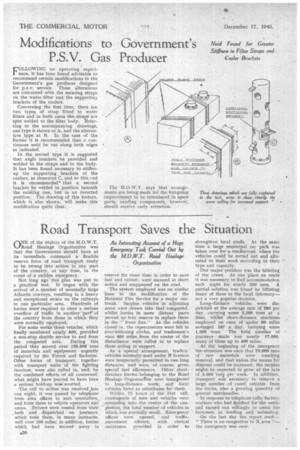Road Transport Saves the Situation
Page 22

If you've noticed an error in this article please click here to report it so we can fix it.
An Interesting Account of a Huge Emergency Task Carried Out by the M.O.W.T. Road Haulage Organization (\ NE of the objects of the M.O.W.T. k Jr Road Haulage Organization was that the Government should have at its immediate command a flexible reserve force of road transport ready to be swung into action in any part of the country, at any time, in the event of a sudden emergency.
Not long ago this plan was put to a practical test. It began with the arrival of a number of unusually. large Atlantic convoys, resulting in a heavy and exceptional strain on the railways in one particular area. Hundreds of lorries were'required to clear a serious overflow of traffic in another-part of the country from those in which they were normally employed.
For some weeks these vehicles, which finally numbered nearly 800, provided a non-stop shuttle service to and from the congested area. During this period they moved over 120,000 tons of materials and equipment urgently required by the Forces and factories. Other forms of transport, together with transport units of the fighting Services, were also called in, and, by the combined efforts of all concerned, what might have proved to have been a serious hold-up was< averted.
The call to action was received slate one night, it was passed by telephone from area offices to Unit controllers,. and from them to vehicle operators and crews. Drivers were roused from their , beds and dispatched on journeys, which took them, in many instances, well over 100 miles; in addition, lorries which had been stowed away in reserve for some time in order to save fuel and rubber, were manned at short notice and reappeared on the road.
The system employed was on similar lines to the mobilization of the National Fire Service for a major outbreak. Surplus vehicles in adjoining areas were drawn into that congested, whilst lorries in more distant parts moved up into reserve to replace those in the " front line." • As the vehicles closed in, the repercussions were felt in ever-widening circles, and tradesmen's vans 490 miles from the centre of the disturbance were called in to replace those acting in support.
As a special arrangement, traders' vehicles nonnally,used under B licences were temporarily permitted to run long distances, and were, of course, given special fuel allowances. Other shortdistance lorries belonging to the Road Haulage Organizaton were transjerred to long-distance work, and local vehicles hired as substitutes for them.
Within. 12 hours of the first call, contingents of men and vehicles were streaming into 'the centre of the congestion, the total number of vehicles in which was normally small. Emergency offices were opened, " and trafficmovement officers, with clerical assistance, provided in order to'
strengthen local staffs. At the same time a large municipal car park was -taken over for a rendezvous, where the vehicles could be sorted out and allocated to their work according to their type and capacity.
One major problem was the billeting of the crews. At one place en route it was necessary to find accommodation each night for nearly 200 men. A partial solution was found by billeting Many of them in the local infirmary— not a very popular decision.
Long-distance vehicles were dis: patched at the average rate of 280 per day, carrying some 2,200 tons at a time, whilst short-distance machines employed on runs of under 80 miles averaged 187 a day, carrying some 1,200 taus. The total number of journeys made was nearly 17,000, Many of them up to 400 miles.
At the' beginning of the emergency the situation was such that 75,000 tons of raw materials were awaiting removal, and that unless the means for disposal could be increased, the surplus might be expected to grow at the rate of 3,000 tonl per week, , In addition,. transport was necessary to remove a large number of cased vehicles from the docks, also a growing quantity of general merchandise. . . -In response to. telephone calls, factory workers who had-finished for the weekend turned out willingly, to asSist the lorrymen. in "loading and unloading. On the last day the report read:— " There is no congestion in X.,area "— the emergency was oyer.




















































